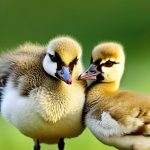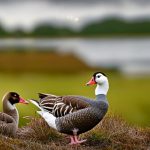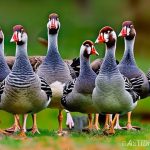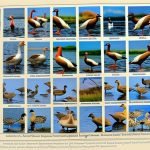Geese are known for their intricate mating rituals, which are essential for the continuation of their species. These rituals often begin with the male geese performing elaborate displays to attract the attention of potential mates. These displays can include honking, flapping their wings, and even performing acrobatic aerial displays. Once a female goose is interested, the pair will engage in a courtship dance, which involves synchronized movements and vocalizations. This dance helps to strengthen the bond between the pair and ensures that they are ready to mate.
After the courtship dance, the male and female geese will mate, often forming a monogamous pair for the breeding season. This bond is crucial for the successful rearing of their offspring, as both parents play a role in protecting and nurturing their eggs. The intricate mating rituals of geese not only ensure the continuation of their species but also contribute to the social structure of their breeding grounds.
Geese are known for their intricate mating rituals, which are essential for the continuation of their species. These rituals often begin with the male geese performing elaborate displays to attract the attention of potential mates. These displays can include honking, flapping their wings, and even performing acrobatic aerial displays. Once a female goose is interested, the pair will engage in a courtship dance, which involves synchronized movements and vocalizations. This dance helps to strengthen the bond between the pair and ensures that they are ready to mate.
After the courtship dance, the male and female geese will mate, often forming a monogamous pair for the breeding season. This bond is crucial for the successful rearing of their offspring, as both parents play a role in protecting and nurturing their eggs. The intricate mating rituals of geese not only ensure the continuation of their species but also contribute to the social structure of their breeding grounds.
The Importance of Breeding Grounds for Geese
Breeding grounds are essential for the survival of geese, as they provide a safe and suitable environment for mating, nesting, and raising their young. Geese typically choose breeding grounds that offer ample food sources, such as grasses, sedges, and aquatic plants, as well as protection from predators. These breeding grounds are often located near bodies of water, such as lakes, ponds, or marshes, which provide the necessary resources for the geese to thrive.
In addition to providing food and protection, breeding grounds also play a crucial role in maintaining the genetic diversity of geese populations. By returning to the same breeding grounds year after year, geese are able to form strong social bonds with other members of their species and pass on valuable knowledge about migration routes and feeding areas. This helps to ensure the long-term survival of geese populations and contributes to the overall health of their ecosystems.
Breeding grounds are essential for the survival of geese, as they provide a safe and suitable environment for mating, nesting, and raising their young. Geese typically choose breeding grounds that offer ample food sources, such as grasses, sedges, and aquatic plants, as well as protection from predators. These breeding grounds are often located near bodies of water, such as lakes, ponds, or marshes, which provide the necessary resources for the geese to thrive.
In addition to providing food and protection, breeding grounds also play a crucial role in maintaining the genetic diversity of geese populations. By returning to the same breeding grounds year after year, geese are able to form strong social bonds with other members of their species and pass on valuable knowledge about migration routes and feeding areas. This helps to ensure the long-term survival of geese populations and contributes to the overall health of their ecosystems.
The Nurturing and Protection of Goose Eggs
Once a female goose has laid her eggs, both parents play a crucial role in nurturing and protecting them until they hatch. The female goose will carefully construct a nest using grasses and other plant materials, often lining it with down feathers to provide insulation for the eggs. She will then lay her eggs one at a time, typically laying between 4-6 eggs over a period of several days.
After all the eggs have been laid, both parents take turns incubating them by sitting on the nest to keep them warm and safe from predators. This process can last for around 25-30 days, during which time the parents must remain vigilant and attentive to ensure the eggs have the best chance of hatching successfully.
Once the eggs hatch, the parents continue to protect and care for their young goslings, teaching them how to find food and navigate their environment. The nurturing and protection of goose eggs is essential for the survival of their offspring and contributes to the overall success of their breeding grounds.
Once a female goose has laid her eggs, both parents play a crucial role in nurturing and protecting them until they hatch. The female goose will carefully construct a nest using grasses and other plant materials, often lining it with down feathers to provide insulation for the eggs. She will then lay her eggs one at a time, typically laying between 4-6 eggs over a period of several days.
After all the eggs have been laid, both parents take turns incubating them by sitting on the nest to keep them warm and safe from predators. This process can last for around 25-30 days, during which time the parents must remain vigilant and attentive to ensure the eggs have the best chance of hatching successfully.
Once the eggs hatch, the parents continue to protect and care for their young goslings, teaching them how to find food and navigate their environment. The nurturing and protection of goose eggs is essential for the survival of their offspring and contributes to the overall success of their breeding grounds.
The Social Structure of Geese in Breeding Grounds
Geese are highly social birds that form strong bonds with other members of their species within their breeding grounds. These social bonds are essential for maintaining order within the group and ensuring that all members have access to food and protection from predators.
Within a breeding ground, geese often form small family groups consisting of a monogamous pair and their offspring. These family groups will often join together with other families to form larger flocks, which can provide additional protection and support for all members.
The social structure of geese in breeding grounds also includes complex communication methods, such as honking and body language, which help to maintain order within the group and coordinate activities such as feeding and migration. Overall, the social structure of geese in breeding grounds is essential for their survival and contributes to the overall health of their ecosystems.
Geese are highly social birds that form strong bonds with other members of their species within their breeding grounds. These social bonds are essential for maintaining order within the group and ensuring that all members have access to food and protection from predators.
Within a breeding ground, geese often form small family groups consisting of a monogamous pair and their offspring. These family groups will often join together with other families to form larger flocks, which can provide additional protection and support for all members.
The social structure of geese in breeding grounds also includes complex communication methods, such as honking and body language, which help to maintain order within the group and coordinate activities such as feeding and migration. Overall, the social structure of geese in breeding grounds is essential for their survival and contributes to the overall health of their ecosystems.
The Challenges and Dangers Faced by Geese in Breeding Grounds
Despite their strong social structure and protective instincts, geese face numerous challenges and dangers within their breeding grounds. One of the most significant threats comes from predators such as foxes, raccoons, and birds of prey, which can pose a serious risk to both eggs and young goslings.
In addition to predators, geese also face challenges from human activities such as habitat destruction, pollution, and climate change. These factors can disrupt their natural behaviors and make it more difficult for them to find suitable breeding grounds or access essential resources such as food and water.
Furthermore, competition with other bird species can also pose challenges for geese within their breeding grounds. As they compete for limited resources such as nesting sites and food sources, conflicts can arise that threaten the well-being of both geese and other bird species.
Despite these challenges, geese have developed various strategies to adapt and survive within their breeding grounds. By working together within their social structure and utilizing their keen instincts for protection and nurturing, geese are able to overcome many of these challenges and ensure the successful continuation of their species.
Despite their strong social structure and protective instincts, geese face numerous challenges and dangers within their breeding grounds. One of the most significant threats comes from predators such as foxes, raccoons, and birds of prey, which can pose a serious risk to both eggs and young goslings.
In addition to predators, geese also face challenges from human activities such as habitat destruction, pollution, and climate change. These factors can disrupt their natural behaviors and make it more difficult for them to find suitable breeding grounds or access essential resources such as food and water.
Furthermore, competition with other bird species can also pose challenges for geese within their breeding grounds. As they compete for limited resources such as nesting sites and food sources, conflicts can arise that threaten the well-being of both geese and other bird species.
Despite these challenges, geese have developed various strategies to adapt and survive within their breeding grounds. By working together within their social structure and utilizing their keen instincts for protection and nurturing, geese are able to overcome many of these challenges and ensure the successful continuation of their species.
The Role of Geese in Ecosystems
Geese play a crucial role in ecosystems by contributing to nutrient cycling through their feeding habits. As herbivores, they consume large quantities of grasses, sedges, and aquatic plants, which helps to control vegetation growth in wetland areas. This grazing behavior also helps to create open spaces that benefit other wildlife species such as waterfowl, amphibians, insects, and small mammals.
In addition to nutrient cycling, geese also contribute to seed dispersal by consuming seeds from various plant species and then excreting them in different locations. This process helps to promote plant diversity within ecosystems by spreading seeds across different habitats.
Furthermore, geese also serve as an important food source for predators such as foxes, coyotes, eagles, and other birds of prey. By providing sustenance for these predators, geese help to maintain balance within ecosystems by supporting diverse food webs.
Overall, the role of geese in ecosystems is multifaceted and essential for maintaining healthy wetland habitats that support a wide range of plant and animal species.
Geese play a crucial role in ecosystems by contributing to nutrient cycling through their feeding habits. As herbivores, they consume large quantities of grasses, sedges, and aquatic plants, which helps to control vegetation growth in wetland areas. This grazing behavior also helps to create open spaces that benefit other wildlife species such as waterfowl, amphibians, insects, and small mammals.
In addition to nutrient cycling, geese also contribute to seed dispersal by consuming seeds from various plant species and then excreting them in different locations. This process helps to promote plant diversity within ecosystems by spreading seeds across different habitats.
Furthermore, geese also serve as an important food source for predators such as foxes, coyotes, eagles, and other birds of prey. By providing sustenance for these predators, geese help to maintain balance within ecosystems by supporting diverse food webs.
Overall, the role of geese in ecosystems is multifaceted and essential for maintaining healthy wetland habitats that support a wide range of plant and animal species.
Conservation Efforts to Protect Geese and Their Breeding Grounds
Conservation efforts aimed at protecting geese and their breeding grounds are crucial for ensuring the long-term survival of these iconic bird species. One key conservation strategy involves creating protected areas such as national parks or wildlife refuges where geese can safely breed without disturbance from human activities or predators.
In addition to protected areas, conservation efforts also focus on habitat restoration projects that aim to improve wetland habitats by restoring natural water flow patterns, controlling invasive plant species, and reducing pollution levels. These projects help to create suitable breeding grounds for geese while also benefiting other wildlife species that rely on wetland habitats.
Furthermore, education programs aimed at raising awareness about the importance of geese in ecosystems can help garner public support for conservation efforts. By engaging local communities in conservation initiatives such as habitat restoration projects or monitoring programs, conservationists can work together with stakeholders to protect geese and their breeding grounds effectively.
Overall, conservation efforts play a vital role in safeguarding geese populations and ensuring that they have access to suitable breeding grounds where they can thrive for generations to come.
Conservation efforts aimed at protecting geese and their breeding grounds are crucial for ensuring the long-term survival of these iconic bird species. One key conservation strategy involves creating protected areas such as national parks or wildlife refuges where geese can safely breed without disturbance from human activities or predators.
In addition to protected areas, conservation efforts also focus on habitat restoration projects that aim to improve wetland habitats by restoring natural water flow patterns, controlling invasive plant species, and reducing pollution levels. These projects help to create suitable breeding grounds for geese while also benefiting other wildlife species that rely on wetland habitats.
Furthermore, education programs aimed at raising awareness about the importance of geese in ecosystems can help garner public support for conservation efforts. By engaging local communities in conservation initiatives such as habitat restoration projects or monitoring programs, conservationists can work together with stakeholders to protect geese and their breeding grounds effectively.
Overall,
conservation efforts play a vital role in safeguarding geese populations
and ensuring that they have access
to suitable breeding grounds where they can thrive
for generations
to come.
Overall,
conservation efforts play
a vital role
in safeguarding
geese populations
and ensuring
that they have access
to suitable
breeding
grounds where they can thrive
for generations
to come.
Overall,
conservation efforts play
a vital role
in safeguarding
geese populations
and ensuring
that they have access
to suitable
breeding
grounds where they can thrive
for generations
to come.
Overall,
conservation efforts play
a vital role
in safeguarding
geese populations
and ensuring
that they have access
to suitable
breeding
grounds where they can thrive
for generations
to come.
Overall,
conservation efforts play
a vital role
in safeguarding
geese populations
and ensuring
that they have access
to suitable
breeding
grounds where they can thrive
for generations to come. This includes providing a healthy and sustainable environment for future generations of plants, animals, and humans. By taking care of the land and ensuring its productivity, we can ensure that our natural resources will be available for our children and grandchildren. This long-term approach to stewardship is essential for preserving the beauty and diversity of our planet for generations to come.
Meet Walter, the feathered-friend fanatic of Florida! Nestled in the sunshine state, Walter struts through life with his feathered companions, clucking his way to happiness. With a coop that’s fancier than a five-star hotel, he’s the Don Juan of the chicken world. When he’s not teaching his hens to do the cha-cha, you’ll find him in a heated debate with his prized rooster, Sir Clucks-a-Lot. Walter’s poultry passion is no yolk; he’s the sunny-side-up guy you never knew you needed in your flock of friends!







